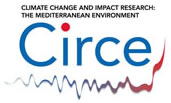Urban case studies
Mediterranean cities, especially those in the east and the south of the region, currently face multiple challenges. Heatwaves and flash floods, health effects of air pollution, saltwater intrusion, and an inadequacy of energy and water resources, are among some of the problems expected to intensify under climate change. A multi-sector approach to climate change impacts will be adopted. The impacts covered will range from direct climate impacts on natural ecosystems to indirect impacts resulting from cascading climate-social-economic linkages. Potential adaptation measures will be examined across impact sectors for each case study.

Athens, Greece is a large metropolitan city with around 4 million inhabitants and a densely populated urban area with few green open spaces. The topography of the city, surrounded by mountains, favours the formation of air pollution episodes during periods of anticyclonic circulation. The city is prone to heatwaves in the summer and floods during heavy precipitation events. Impacts of climate change extremes and air pollution on human health, tourism, energy demand and peri-urban forest fire risk will be examined in this case study.
Beirut, Lebanon is the largest metropolitan area in Lebanon with around 2 million inhabitants, nearly half of the country’s population. It is a densely populated urban area renowned for problems of water shortage. In addition to the pressures of high population growth, water demand has been rising in response to the growth in tourism and industrial development. Consequently, Beirut experiences an acute water deficit leading to intermittent supply in most areas, coupled with a lack of piped water supply to a large number of poor areas. This case study will assess the socio-economic implications of rising water demand and deteriorating water quality associated with climate change, and the development of adaptation and conservation strategies.
Alexandria, Egypt is the largest city in the West Nile Delta with a population of over 3.5 million. The Greater Alexandria area is an important resource for agriculture, tourism and industry, but suffers from severe environmental pollution and a lack of environmental monitoring and regulation. Its deltaic location makes the city vulnerable to sea level rise due to climate change and saltwater intrusion. An exploration of possible adaptation options and an evaluation of the socio-economic problems impeding sustainable development in the region will be undertaken.
![]() Briefing notes: Overview of the urban case studies
Briefing notes: Overview of the urban case studies
![]() Deliverable report (D11.3.3) on the CIRCE urban heat island simulations
Deliverable report (D11.3.3) on the CIRCE urban heat island simulations
 Integrating Case Studies
Integrating Case Studies